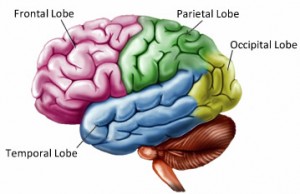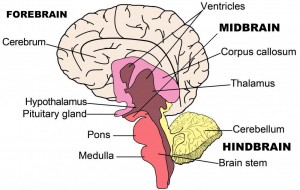(Human Brain Structure and Their Functions in Human Body, 2019)
The brain is one of the largest organs in the body and is what ultimately controls everything the human body is capable of. The brain is part of the central nervous system along with the spinal cord. The brain is divided into three major divisions; the forebrain, the midbrain, and the hindbrain (McCance & Huether, 2019). The forebrain includes the telencephalon and diencephalon. The midbrain includes the corpora quadrigemina, tegmentum and cerebral peduncles. Lastly, the hindbrain includes the cerebellum, pons, and medulla. The brainstem is what connects the hemispheres of the brain, cerebellum, and spinal cord and is made up of the midbrain, medulla, and pons. The brainstem has a large number of nuclei that make what is called reticular formation that control important reflexes. These nuclei connect the brainstem to the cortex and makeup what is called the reticular activating system which is important for maintaining wakefulness and attention (McCance & Huether, 2019).

(Brain Structure And Function: Brain Injury: British Columbia, 2019)
The telencephalon also known as the cerebral hemispheres (left and right) is composed of the cerebral cortex and basal ganglia (McCance & Huether, 2019). The cerebral cortex has an outer layer of neurons that make gray matter. White matter is underneath the cerebral cortex and is made up of axons (McCance & Huether, 2019). The basal ganglia are involved in voluntary motor functions, emotions, cognition, and eye movements. Each hemisphere is divided into lobes. Each lobe is responsible for different functions throughout the body. The frontal lobe is what controls motor function, problem solving and judgement. The parietal lobes which controls handwriting, body position, and manages sensation. The temporal lobes which controls hearing and memory. And lastly, the occipital lobe which manages the brain’s visual processing system. The diencephalon also known as the interbrain has four divisions, epithalamus, thalamus, hypothalamus, and subthalamus (McCance & Huether, 2019). The diencephalon is in charge of important vital involuntary functions (McCance & Huether, 2019). The mesencephalon or the midbrain is made up of the tectum, the tegmentum and the cerebral peduncles. In the tectum there are colliculi that control involuntary visual motor movements and movements that affect the auditory system (McCance & Huether, 2019). The tegmentum has substantia that synthesizes dopamine (McCance & Huether, 2019). The hindbrain has two divisions. The metencephalon has the cerebellum and the pons. While the myelencephalon has the medulla oblongata. The cerebellum is responsible for reflective, involuntary fine-tuning of motor control, maintaining balance and posture (McCance & Huether, 2019). The pons is responsible for transmitting information from the cerebellum to the brainstem. The medulla is responsible for reflex activities such as heart rate, respirations, and blood pressure (McCance & Huether, 2019).

(Brain Structure And Function: Brain Injury: British Columbia, 2019)
The brain receives its arterial supply by way of two systems, the internal carotid arteries and the vertebral arteries (McCance & Huether, 2019). The internal carotid arteries supply the greatest amount of blood flow. They are divided into the anterior and middle cerebral arteries once they enter the skull. The vertebral arteries are made up from the subclavian arteries and enter the cranium through the foramen magnum (McCance & Huether, 2019). They eventually form the basilar artery which then divides in the posterior cerebral arteries (McCance & Huether, 2019). These two systems can be broken down into superficial arteries that are on the surface of the brain also known as conducting arteries and projecting arteries that are small branches that project into the brain also known as nutrient arteries (McCance & Huether, 2019). A stroke can arise in the brain itself or in the arteries of the brain. If a stroke occurs in any of these parts of the brain it can cause irreversible effects that can be detrimental.